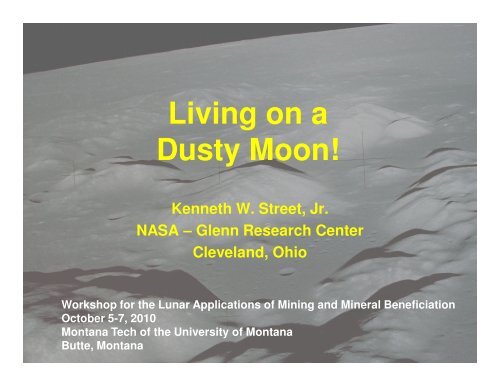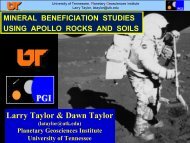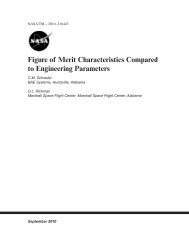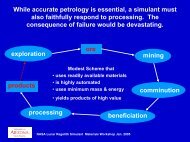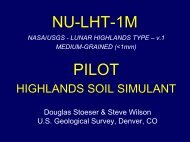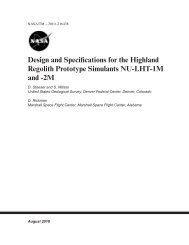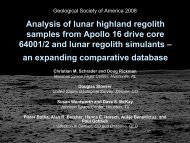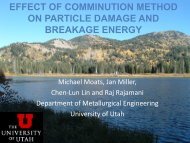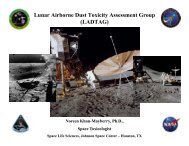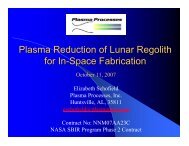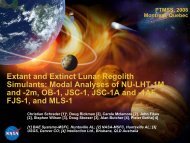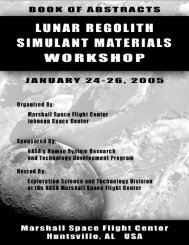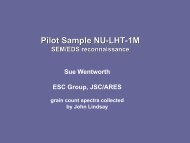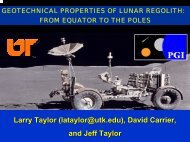Presentation - In Situ Resource Utilization (ISRU) - NASA
Presentation - In Situ Resource Utilization (ISRU) - NASA
Presentation - In Situ Resource Utilization (ISRU) - NASA
You also want an ePaper? Increase the reach of your titles
YUMPU automatically turns print PDFs into web optimized ePapers that Google loves.
Living on a<br />
Dusty Moon!<br />
Kenneth W. Street, Jr.<br />
<strong>NASA</strong> – Glenn Research Center<br />
Cleveland, Ohio<br />
Workshop for the Lunar Applications of Mining and Mineral Beneficiation<br />
October 5-7, 2010<br />
Montana Tech of the University of Montana<br />
Butte, Montana
To the Moon and Beyond<br />
Space<br />
Exploration<br />
<strong>In</strong>itiative<br />
9/12/1962<br />
<strong>NASA</strong>’s Vision for Space Exploration<br />
(<strong>NASA</strong>, 2004)<br />
– undertake lunar exploration activities<br />
to enable sustained human and robotic<br />
exploration of Mars and more distant<br />
destinations in the solar system<br />
2010 – President Obama’s vision is a bit different!
The Moon 101
The Moon 101<br />
Highlands<br />
Anorthositic<br />
(feldspar-rich)<br />
basaltic-rich
The Lunar Environment<br />
Highlands
The Lunar Environment<br />
Solar<br />
Photons<br />
*<br />
Non Polar<br />
Polar<br />
Temperature -150°C to +100°C -50°C ± 10°C *<br />
Sunlight<br />
Darkness<br />
~354 hours<br />
± 90° <strong>In</strong>cidence Angle<br />
~354 hours<br />
~ 530 to 708 hours<br />
± 1.7° <strong>In</strong>cidence Angle<br />
0 to 148 hours<br />
(discontinuous)<br />
H Content (avg.) 10-90 ppm >150 ppm<br />
<strong>Resource</strong> Potential<br />
Direct Earth<br />
Communications<br />
Solar wind gases<br />
Bound oxygen<br />
Continuous on near side<br />
Solar wind gases<br />
Bound oxygen<br />
Shadowed volatiles<br />
Discontinuous<br />
but predictable<br />
(~ ½ time in Earth view)<br />
* Shackelton Crater = Totally shadowed and 40K (-233 o C)!
20 km/s = 44,000 mph!
Lunar Gardening<br />
<strong>In</strong> the absence of atmosphere (10 -12 Torr)…
Agglutinates<br />
<strong>In</strong>dividual particles – aggregates of smaller<br />
particles (mineral grain, glass, rocks, older<br />
agglutinates) bonded together by vesicular flow<br />
banded glass in varying proportions. 30-80%<br />
glass<br />
100 µm<br />
Vesicles (holes): liberated solar wind gases<br />
and generated H 2 O (FeO + 2H = Fe +H 2 O)<br />
Contain minute droplets of near pure Fe metal<br />
(very fine grained single domain Fe 0 , 30-100Å<br />
mounds and trains of metal Fe, attached to grains
40 nm<br />
Nano Phase Fe<br />
50 nm
Composition - Minerals<br />
Anorthite CaAl 2<br />
Si 2<br />
O 8 (Ca,Na)(Si,Al) 4 O 8<br />
Bytownite (Ca,Na)(Si,Al) 4<br />
O 8<br />
Labradorite (Ca,Na)(Si,Al) 4<br />
O 8<br />
Olivine (Mg,Fe) 2<br />
SiO 4<br />
Fayalite Fe 2<br />
SiO 4<br />
Forsterite Mg 2<br />
SiO 4<br />
Clinoenstatite Mg 2<br />
[Si 2<br />
O 6<br />
]<br />
Pigeonite (Mg,Fe +2 ,Ca) 2<br />
[Si 2<br />
O 6<br />
]<br />
Hedenbergite CaFe +2 [Si 2<br />
O 6<br />
]<br />
Augite (Ca,Na)(Mg,Fe,Al,Ti)[(Si,Al) 2<br />
O 6<br />
]<br />
Enstatite Mg 2<br />
[Si 2<br />
O 6<br />
]<br />
Spinel MgAl 2<br />
O 4<br />
Hercynite Fe +2 Al 2<br />
O 4<br />
Ulvospinel<br />
Chromite<br />
TiFe +2 2 O 4<br />
Fe +2 Cr 2<br />
O 4<br />
Troilite<br />
FeS<br />
Whitlockite<br />
Ca 9<br />
(Mg,Fe +2 )(PO 4<br />
) 6<br />
(PO 3<br />
OH)<br />
Apatite<br />
Ca 5<br />
(PO 4<br />
) 3<br />
(OH,F,Cl)<br />
Ilmenite Fe +2 TiO 3<br />
Native Iron<br />
Fe
Composition - Rocks
Depth of Lunar Regolith (Dirt)<br />
Mare ~5 m<br />
Highland ~10 m<br />
Dust:
Q: Why is lunar dust<br />
a problem<br />
A: It gets<br />
everywhere!
Lunar Dust - Apollo Era Issues<br />
Vision obscuration<br />
– landing blew dust starting at 100 ft<br />
False instrumentation readings<br />
– velocity trackers locked onto dust at 30 ft<br />
Loss of traction<br />
– adherence to boot soles<br />
Clogging of mechanisms<br />
– conveyor, lock buttons, camera, …..<br />
Abrasion<br />
– outer layer of insulation, pressure failures, face plate scratched, ….<br />
Thermal control<br />
– radiator shields covered<br />
Seal failures<br />
– pressure decay on Pete Conrad’s EMS<br />
<strong>In</strong>halation and irritation<br />
– pungent odor, eye and lung irritant<br />
Excessive cleaning time<br />
– brushing off, wiping down<br />
EVA: Extra Vehicular Activity<br />
Electrical conductivity<br />
– discharge harming electronic/radio systems
The Terminator Cometh<br />
Solar Photons exceed the work<br />
function of atoms<br />
Particle charge approaches 10 4<br />
Dust levitates to altitude of over 1 km
<strong>NASA</strong> TRLs<br />
TRL 1 Basic principles observed and reported<br />
TRL 2 Technology concept and/or application formulated<br />
TRL 3 Analytical and experimental critical function and/or characteristic<br />
proof-of- concept<br />
TRL 4 Component and/or breadboard validation in laboratory environment<br />
TRL 5 Component and/or breadboard validation in relevant environment<br />
TRL 6 System/subsystem model or prototype demonstration in a relevant<br />
environment (ground or space)<br />
TRL 7 System prototype demonstration in a space environment<br />
TRL 8 Actual system completed and “flight qualified” through test and<br />
demonstration (ground or space)<br />
TRL 9 Actual system “flight proven” through successful mission operations<br />
TRL: Technology Readiness Level
The Dreaded TRL 6!<br />
TRL 1 Basic principles observed and reported<br />
TRL 2 Technology concept and/or application formulated<br />
TRL 3 Analytical and experimental critical function and/or characteristic<br />
proof-of- concept<br />
TRL 4 Component and/or breadboard validation in laboratory environment<br />
TRL 5 Component and/or breadboard validation in relevant environment<br />
TRL 6 System/subsystem model or prototype demonstration in a relevant<br />
environment (ground or space)<br />
TRL 7 System prototype demonstration in a space environment<br />
TRL 8 Actual system completed and “flight qualified” through test and<br />
demonstration (ground or space)<br />
TRL 9 Actual system “flight proven” through successful mission operations<br />
Cost to ship equipment to moon = ~$1M/Lb (circa 2009)
A Case Study in TRL 6<br />
Wheeeee!!!!<br />
Oops.
Dust Toxicology<br />
Dust gave off a distinctive, pungent odor<br />
(Scott - it smelled a bit like gun powder)<br />
Apollo 12 dust was an eye and lung<br />
irritant during the entire trip back.<br />
Perhaps not so fun!<br />
Fun!
Back to TRL 6<br />
Between 1969 and 1972 six Apollo missions<br />
382 kilograms (842 pounds)<br />
lunar rocks, core samples, pebbles, sand<br />
and dust
Back to TRL 6<br />
382 kg (842 pounds)<br />
does not make the 40 Tons (80,000 Lb)<br />
required to fill a sandbox!
JSC-1…. and 1A!<br />
BP-1<br />
NU-LHT<br />
MLS-1 & 2<br />
GRC 1& 3<br />
Simulants!<br />
OB-1<br />
ChEn-OB<br />
KOHLS-1<br />
JSC-Mars-1A<br />
And now for that<br />
Quiz!<br />
FJS-1<br />
MKS-1<br />
CAS-1 and<br />
now 2 more
JSC-1…. and 1A!<br />
BP-1<br />
NU-LHT<br />
MLS-1 & 2<br />
GRC 1& 3<br />
Simulants!<br />
OB-1<br />
ChEn-OB<br />
KOHLS-1<br />
JSC-Mars-1A<br />
Who can pronounce<br />
“Pu’u Nene”<br />
FJS-1<br />
MKS-1<br />
CAS-1 and<br />
now 2 more
Dust Management Program<br />
Task 1.4.1 – Regolith Characterization<br />
Task 1.4.3 – Simulant Development and Characterization
National Aeronautics and Space Administration<br />
The 5 Most Important Properties<br />
Particle Size Distribution and Shape<br />
Adhesion, Friability and Elasticity<br />
Abrasion<br />
Tribo-charging & Electrostatics<br />
Surface Reactivity and Chemistry (especially Corrosion)<br />
Composition<br />
Magnetic susceptibility, dielectric function & conductance<br />
Surface Energy<br />
Thermal Properties & evolved Gases<br />
Emissivity<br />
www.nasa.gov
National Aeronautics and Space Administration<br />
The FOMS (an MSFC Effort)<br />
Figures of Merit (FOMs)<br />
Prediction of simulant – Regolith similarity<br />
Based on few key properties from which all other derived<br />
Particle Size<br />
Particle Shape<br />
Particle Composition<br />
Density (bulk)<br />
Then there’s the emissivity issue…<br />
www.nasa.gov
Thermal Properties of <strong>In</strong>terest<br />
<strong>In</strong> order to achieve a sustainable presence on<br />
the Moon (or elsewhere) it will be necessary<br />
to process materials in-situ to provide shelter,<br />
bioconsumables, etc.<br />
Melting Temperature<br />
Preparation of construction materials<br />
Energy Budget<br />
Evolution of Gaseous Material<br />
Production of Water and Oxygen
National Aeronautics and Space Administration<br />
Mineral %<br />
Anorthite<br />
A<br />
Bytownite<br />
M<br />
Labradorite<br />
M<br />
Olivine<br />
M<br />
Fayalite -<br />
Forsterite -<br />
Clinoenstatite M<br />
Pigeonite<br />
M<br />
Hedenbergite M<br />
Augite<br />
M<br />
Enstatite<br />
A<br />
Spinel<br />
m<br />
Hercynite<br />
m<br />
Ulvospinel<br />
m<br />
Chromite<br />
m<br />
Troilite<br />
t<br />
Whitlockite<br />
t<br />
Apatite<br />
t<br />
Ilmenite<br />
m<br />
Native Iron<br />
t<br />
+ Norite Glass A<br />
Lunar Composition<br />
www.nasa.gov
National Aeronautics and Space Administration<br />
Equipment Design<br />
All interactions people and equipment will have<br />
with the surface of the Moon will be with the regolith.<br />
Design engineers are now<br />
asking what materials and<br />
what over-design factors.<br />
www.nasa.gov
National Aeronautics and Space Administration<br />
Adhesion<br />
Ti Alloy<br />
Silica<br />
Teflon<br />
Norite Glass<br />
Anorthite<br />
Enstatite<br />
Auger Analysis<br />
Adhesion<br />
(pull-off<br />
force), mN<br />
3.5<br />
3<br />
2.5<br />
2<br />
1.5<br />
1<br />
Clean<br />
Atomically<br />
clean<br />
diamond<br />
Atomically<br />
clean<br />
sapphire<br />
Miyoshi’s Rig<br />
~10 -14 Torr<br />
Diamond<br />
Sapphire<br />
Air Exposed!<br />
0.5<br />
Diamond with<br />
adsorbed<br />
species<br />
Sapphire with<br />
adsorbed<br />
species<br />
0<br />
Surface Condition (Ni)<br />
www.nasa.gov
National Aeronautics and Space Administration<br />
Abrasion<br />
Mineral Mohs Mode: Fracture %<br />
Anorthite 6 Conchoidal A<br />
Labradorite 7 Conchoidal M<br />
Enstatite 5.0-6.0 Conchoidal A<br />
Relating Abrasivity<br />
to Hardness<br />
Spinel 7.5-8.0 Conchoidal m<br />
Hercynite 7.5-8 Uneven m<br />
Ulvospinel 5.5-6.0 Uneven m<br />
KHN ~ 1500 for<br />
“Terrestrial” Spinel<br />
www.nasa.gov
National Aeronautics and Space Administration<br />
Abrasion & Equipment Design<br />
Sinus Aestuum<br />
Spinel<br />
Lunar Regolith<br />
will cause extreme<br />
wear to Metals<br />
and Plastics<br />
www.nasa.gov
National Aeronautics and Space Administration<br />
Emissivity (Emittance)<br />
The Conservation Law:<br />
α(λ) + ρ(λ) + T(λ) = 1<br />
where T = 0, absorptance = [1 - ρ(λ)]<br />
through Kirchhoff's Law, α(λ) = ε(λ)<br />
The Battery Cooling Problem<br />
Regolith has high absorptance, low emittance<br />
Dust is an insulator and also acquires heat from light<br />
Thermal radiators have a big dust problem!<br />
www.nasa.gov
National Aeronautics and Space Administration<br />
Conclusions<br />
“I think dust is probably one of our greatest inhibitors to a nominal<br />
operation on the Moon. I think we can overcome other physiological<br />
or physical or mechanical problems except dust.”<br />
- Gene Cernan, Apollo 17 (technical crew debriefing)<br />
We need to get to work!<br />
- Regolith Evaluation<br />
- Simulant Evaluation<br />
- Figures of Merit (FoMs)<br />
- Simulant Design & Production<br />
www.nasa.gov
Acknowledgements<br />
Jeff Plescia – Applied Physics Lab, Johns Hopkins University<br />
Ryan Kobrick – University of Colorado/GRC<br />
Paul Greenberg – GRC<br />
James Gaier – GRC<br />
Mark Hyatt – GRC<br />
Barry Hillard – GRC<br />
Da-Ren Chen – Washington University in St. Louis<br />
Ta-Chih “TC” Hsiao – Washington University in St. Louis<br />
Kazuhisa “K” Miyoshi – GRC/Retired<br />
Sponsored by the GRC DMP<br />
And you for listening!


